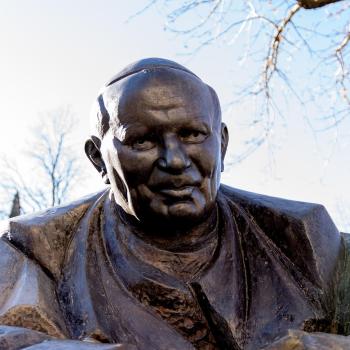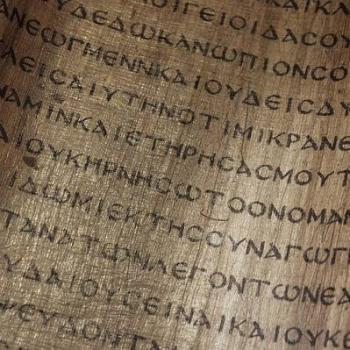JACK’S QUESTION:
What do we know about Joseph of Arimathea? Have scholars learned anything more about him than what is said in the Gospels?
THE RELIGION GUY’S ANSWER:
The man who buried Jesus is a timely topic for Christians’ Holy Week. The quick response is that lots of stuff about Joseph of Arimathea is floating around out there. But much of it was written long centuries after the fact and is best regarded as folklore that tells us about British national pride rather than the actual man and his history.
The four New Testament Gospels are by far the best available sources and, scholars tell us, the earliest ones, produced in their current form some three to six decades after Jesus’ crucifixion. All four Gospels have information about Joseph, a rare distinction for a minor figure, albeit one who participated in a history-changing event. (References: Matthew 27:57-60, Mark 15:43-46, Luke 23:50-53, John 19:38-42.)
The Gospels’ narratives are broadly similar, but with intriguing differences of the sort that keep exegetes up at night. We’re told Joseph was “rich” and “respected,” asked Rome’s colonial ruler Pilate for custody of Jesus’ corpse, provided his own unused tomb hewn out of rock, personally conducted the burial procedures, and rolled the famous stone across the entrance to seal the gravesite. The burial was witnessed by two women, so the Gospels teach they were not mistaken that it was Jesus’ tomb later found empty.
Mark calls Joseph a member of the “council,” which could refer to Jerusalem’s municipal government. But Luke clarifies that he belonged to the Sanhedrin that asked Pilate to execute Jesus, and says Joseph “had not consented to their purpose and deed.” Thus Mark’s statement that “all” of the Sanhedrin wanted execution can be seen as hyperbole to indicate lopsided rather than 100 percent support. John alone adds that fellow Sanhedrin member Nicodemus, who had defended Jesus during a prior dispute (John 7:50-52), joined Joseph in the burial.
Side comment: This important detail that the Sanhedrin was split helps counter anti-Semitic distortions. And divided opinion did not characterize only the Jewish rulers. Though one crowd yelled “crucify him,” Luke 23:27 reports that Jesus also received sympathy from a “great multitude of the people” lamenting his unjust execution.
Apparently Jesus’ apostles had fled in fear and Jesus’ family did not take responsibility for the burial. Executed criminals were despised and their corpses were often tossed into common graves. So Joseph’s kindly intervention for more dignified burial was notable. Commentators agree that meant some risk to his political, religious, or business reputation. In addition, handling the corpse involved ritual pollution.
Yet Joseph’s action was fully understandable for a God-fearing Jew. He took responsibility to honor the biblical law that said criminals executed “on a tree” must not be left hanging there overnight but be buried the same day (Deuteronomy 21:22-23).
Apparently there was more to it, however, and Joseph was a seeker or full-fledged believer in Jesus. Mark and Luke call him one who was “looking for the kingdom of God” while Matthew goes beyond that, saying he “was a disciple of Jesus.” John adds that he was a disciple “but secretly, for fear of the Jews.”
Final biblical detail: Experts aren’t certain where Arimathea was located, but most likely it was a settlement northwest of Jerusalem at the site of Ramah, the town of the Old Testament prophet Samuel. Joseph coming “from” Arimathea could mean he was a visitor during the crucifixion, but more likely he was already living in Jerusalem, not his hometown.
The magnum opus of technical “higher criticism” about the scriptural accounts is “The Death of the Messiah” (1994) by the late U.S. Catholic Raymond E. Brown. He devotes fully 112 of the 1,608 pages to the verses about Jesus’ burial that contain our only biblical material about Joseph.
Moving from 1st Century Scripture to later writings, Joseph became the subject of elaborate and disputed legends to an unusual degree. The process began with the 2nd Century pseudepigraphal (i.e. non-biblical) “Gospel of Peter.” Its implausible scenario made Joseph a personal friend of Jesus but also of Pilate so that his deed required no special courage. Brown said the text’s claim that Pilate could not act without permission from Herod Antipas shows ignorance about 1st Century Palestine.
The “Acts of Pilate,” probably from the 3rd Century, begins what Brown considers a “florid Joseph legend.” We’re told the Sanhedrin was angry with Joseph and jailed him for burying Jesus, but he escaped miraculously and took the chief priests to interview a man Jesus raised from the dead. There followed what Brown calls “astonishing development” during the Middle Ages. Examples:
The “Life of Mary Magdalene” from 9th Century Germany said Joseph took a 1st Century missionary trip to Britain with the biblical sisters Mary and Martha, and Mary Magdalene. That story was picked up in 11th Century England by William of Malmesbury, who originated Joseph’s link with Glastonbury Abbey. The late 12th Century poet Robert deBoron had Joseph bringing the Holy Grail (Jesus’ Last Supper chalice) to Britain. The 15th Century John of Glastonbury wrote that Joseph also brought two cruets from the Holy Land that contained Jesus’ blood and sweat from the crucifixion.
Other romances depicted Joseph as the Roman Empire’s minister of mining, or Jesus’ great-uncle who took the boyhood Savior along as he explored metal deposits in England, or Asia, or South America.
Things turned political in 1559 when newly crowned Queen Elizabeth I wrote bishops declaring that the self-governing Church of England had existed before the “Romish Church first planted the Catholic” and cited England’s chronicles as proving “Joseph of Arimathea to be the first preacher of the word of God within our realms.” Then we have the misnamed www.biblefacts.org that not only repeats Elizabeth’s contention but says Joseph died at Glastonbury on July 27 in A.D. 82!












